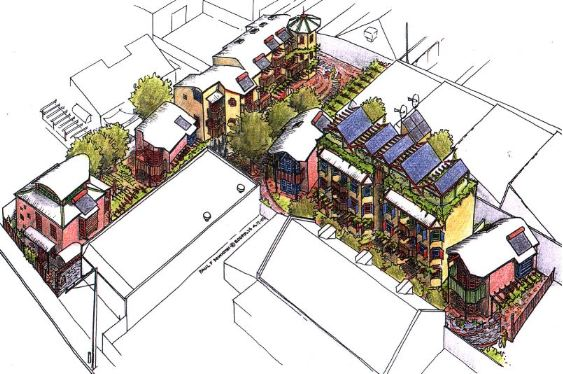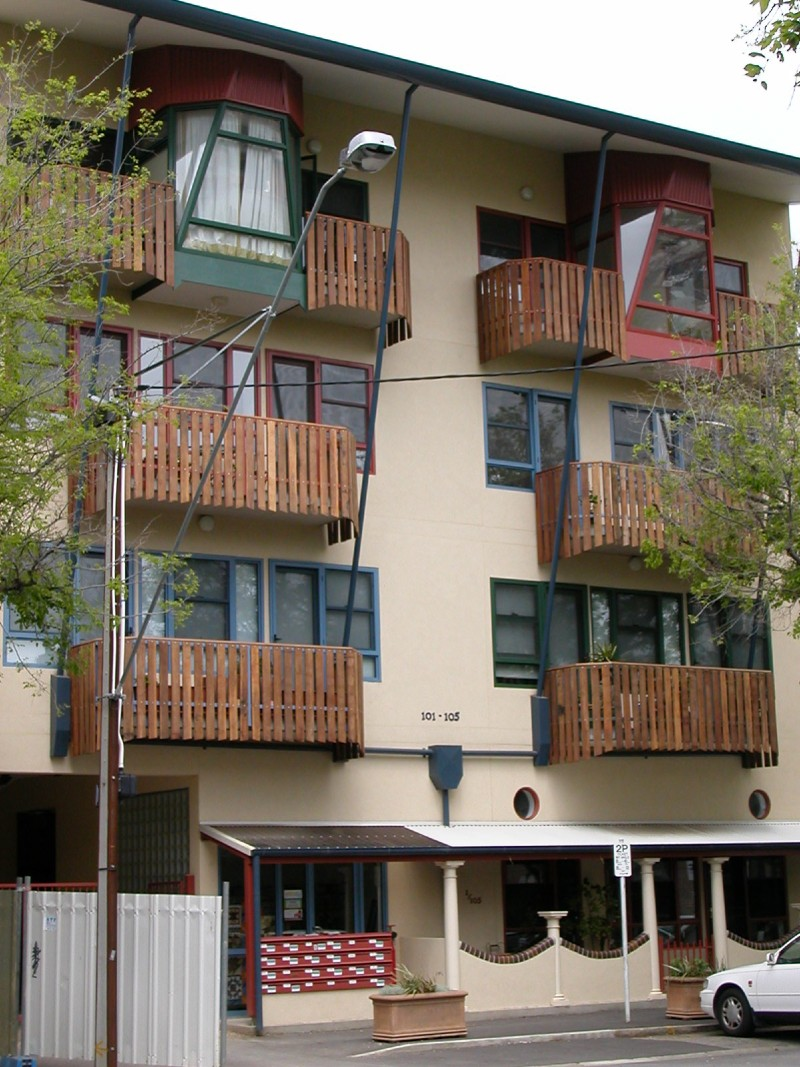Cohousing will grow more rapidly in Australia for three reasons – a drive for efficiency including trends towards collaborative consumption and housing densification, the price of Australian homes with substantial downside risks, and the limited scope for personal expression in the design of new attached homes. Yet social obstacles to this type of venture remain.
Cohousing is a method of property development that works in reverse to traditional development. Likeminded potential homeowners get together to form a group, identify and purchase a site, then design and develop their homes in a cooperative manner. This enables great diversity in the design of individual dwellings, and the complex as a whole, and a fair bit of flexibility in the choice of location. Typically individual homes are smaller than average, but there is a strong emphasis on developing useful common facilities such as a kitchen and dining hall, shared laundry, and often guest rooms. If you want to host dinner party you use to the common function room so in your own apartment you have a smaller kitchen then you might have otherwise required.
Economising on space through extensive sharing can lead to better lifestyle for you dollar, and perversely, greater personal expression in your own the private space.
In principle one would expect that cohousing could deliver homes below the market price, which is particularly attractive in a market with substantial downside risks. Not only is a developer margin not in the cost build up, stamp duty costs can often be avoided (if the development is owned by a separate entity and members own a stake in that entity). There is often also scope for home owners to reduce costs by completing the internal finishes of the dwelling, and outdoor landscaping, themselves, since there is no need to rush to full completion.
The Grattan Institute’s survey on The Housing We’d Choose found that one of the main turn offs of apartment living is that ‘ability to express oneself’. Simply put, home design and renovation is a highly valuable expression of personal identity – as the popularity of renovation reality television clearly reflects. Owners of attached dwellings typically find their ‘housing identity expression’ limited by building designs and body corporate arrangements, and I would bet they probably watch less reality television as a result.
Cohousing emerged in Denmark in the 1960s following a newspaper article entitle “Children should have one hundred parents”, inspiring fifty families to develop a housing project to suit their desired community lifestyle. There are now over one hundred such communities in the US, and in Denmark 5-10% of new homes constructed are by a housing cooperative. The rise of cohousing internationally has inspired the 1st international cohousing conference. The images below are of Christie Walk village in Adelaide, one of Australia’s best examples of urban cohousing.
But, as my Dad often says, if it was easy, everyone would be doing it.
I see two main hurdles during the ascent of cohousing – ownership structure, including the sharing of risks ,and, more importantly, group decision-making.
A common practice for choosing groups is to start a cooperative, a separate legal entity, to own the whole development (even after completion). Members of the cooperative then own a share of that entity, rather than own a title to their own dwelling individually. This structure does not limit the ability to sell your dwelling (as defined by your share of the cooperative), but I would imagine the pool of buyers willing to enter into such arrangements would be reduced. Potential cohousing participants may be cautious about this arrangement, given the added layer of risk (for example, the risk of fraud by others in the group, leaving you without claim to the registered title).
Many cohousing groups now use traditional ownership structures for the completed dwellings to enable members to sell (and new members buy into) the group more easily. But even in this case the apportionment of risk between owners during the development phase needs to clarified in a separate agreement.
Risks at early stages of development are substantial – surprise site issues, town planning approvals, construction cost blowouts and so on. Many cohousing groups partner with professional development companies in order to share some of these risks.
For me personally, the added risk of group decision-making is the major factor holding back the formation of a group amongst my likeminded friends and family. Consider just the first stage of the process – the site purchase. Even if the group is committed to specific suburb and has a reasonable idea of the type of development they desire, it is unlikely that many suitable sites will become available over, say, a two-year window. The most likely scenario is that sites will be either too large, having development potential beyond the requirements of the group, thus too expensive, or too small, and not able to cater for the whole group. Would the group wait indefinitely for the perfect site? To follow through with the project on a small site, how will it be decided who leaves the group? Write names on cards anonymously by torchlight – “Sorry Robbo, the tribe has spoken”?
Another key decision is the design and arrangement of housing and common space. Who gets the dwelling with the best aspect?
Group decisions are not always intractable. The fact that cohousing is growing in popularity is surely a sign that with some trust in the process, and some flexibility of members, projects can be completed. Indeed, cooperative housing has been around in some form for a long time. Yet the dominance of private development demonstrates that the model of a single risk taker and decision maker has a distinct advantage.
The rise of cohousing has seen hybrid approaches adopted, which I see as crucial to gaining mainstream acceptance. Groups willing to partner with a professional developer can commit to sites slightly larger than their needs, giving the group scope to share risk, and the developer the opportunity to sell excess housing stock. Adopting traditional governance structures and private ownership of title also decreases risks for participants (but adds a stamp duty cost).
Private developers are increasingly adopting some of the sharing principles of cohousing, often emphasising shared facilities and smaller dwellings. At Hamilton Northshore in Brisbane, shared cars for residents is on offer, reducing the number of garage spaces required.
But private development by its nature cannot offer the type of process, with its contributions of members to site choice and design, the potential for members to develop housing below market prices, and common passion for community and efficient use of spaces and shared facilities, that makes cohousing so attractive. I expect the list of cohousing projects at the Cohousing Australia website to grow rapidly in the coming years.
Tips, suggestions, comments and requests to [email protected] + follow me on Twitter @rumplestatskin

